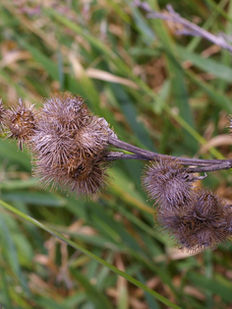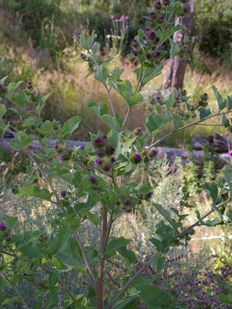top of page

-
Grows up to 2 meters tall
-
A biennial introduced from Europe and Northern Asia

Burdock
(Arctium species)
Quick Identification
-
Large leaves with a wooly underside and wavey edges
-
Light purple or pink flowers
-
Round seed head attach to clothing or fur
-
Similar appearance to rhubarb
Impact
Burdock competes with native vegetations and burs can travel long distances attached to wildlife and livestock. Burs can also damage eyes and can cause temporary or permanent loss of site due to visual obstruction or damage. This plant can be a host for pathogens which affect native species.
Management
Pulling and digging burdock can be effective. Cutting flowerhead or collecting seed can also help to reduce the spread. Biocontrol agents are available and have been released in the Boundary.
Flower
Flowers are light purple or pink and appear July to October and are enclosed in a bur.
Leaves & Stems
In the first year burdock forms a rosette with large leaves and green and red tinged angular and grooved stems. It resembles a rhubarb plant. In the second year a flower stock grows to between 1 and 2 m in height.

Roots
Has a long carrot like taproot.
Reproduction & Dispersal
Only reproduces by seed. Burs are moved by wildlife, range animals, pets, and human activity.
Seeds
One plant can produce up to 1,500 seeds. These remain viable for 1 to 2 years
Preferred Habitat
Burdock has been found to establish in disturbed areas such as pastures, ditches, and old fields.
Interesting Facts
The roots and stalks of this plant are edible and have been used for medicinal purposes.
bottom of page








